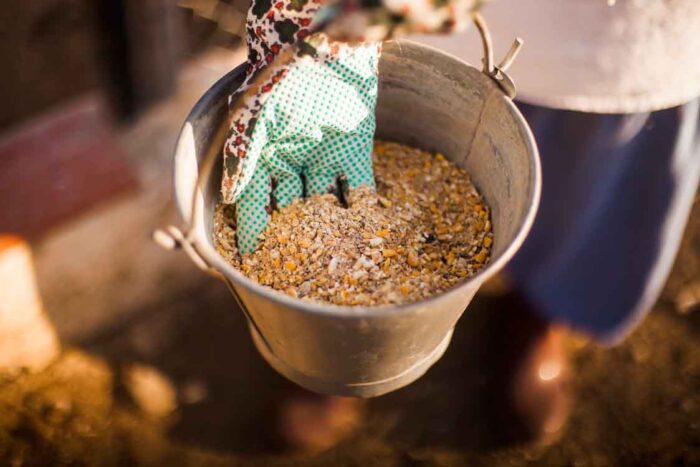Cattle feed should be a balanced source of essential nutrients required for body maintenance, growth and milk production. Here we feature a couple of low cost concentrate feed/compound cattle feed manufacturers based in Tamilnadu, India. The concentrate feed is manufactured using beer malt waste (combination of Maize, barley, wheat), maize corn waste, white tapioca waste, brown tapioca waste, rice husk, turmeric and mineral mix/salt.
Permissible allowed limit per cow is 1 kg/meal.
The concentrate feed comes in 45/50 kg bags and can also be supplied in bulk. The concentrate feed is ideally suited for cows, goats, sheep, pigs. rabbits, poultry and fish.
CONCENTRATE CATTLE FEED
Compound cattle feed is a mixture of various concentrate feed ingredients in suitable proportion. Commonly used ingredients in compound cattle feed include grains, brans, protein meals/cakes, chunnies, agro-industrial by-products, minerals and vitamins. Compound cattle feed is an economical source of concentrate supplements and it could be in the form of mash, pellets, crumbles, cubes, etc.
Compound cattle feed is palatable and good source of nutrients for growing, adult, dry, milk producing and pregnant animals. Through regular use of compound cattle feed in prescribed quantity along with basal diet, cost of milk production from dairy animals can be optimised and net profitability can be increased.
Quality of cattle feed has a direct impact on milk production, reproduction and immunity of dairy animals, and thus profitability of dairy farmers. Quality of cattle feed is also important from the food safety point of view, as most of the contaminants such as Aflatoxin B1, pesticides and heavy metals can be transferred from feed to milk and pose health hazards to humans.
Feeding of growing animals (From 6 months onwards)
For calves below one year of age it is always desirable to give sufficient concentrates in addition to good roughage so that they make optimum growth. Feeding concentrate can be considerably reduced in the case of calves over one year of age fed on high quality roughage. A judicious mixture of roughage and concentrate is essential for obtaining optimum growth without undue fat deposition. From six months onwards, calves can be given the same type of concentrate mixture (14-16% Digestible Crude Protein and about 70% Total Digestible Nutrients) as used for adult cattle. Examples of concentrate mixtures are given separately.
Feeding of lactating cow
Proper feeding of dairy cattle should envisage minimum wastage of nutrients and maximum returns in respect of milk produced.
A concentrate mixture made up of protein supplements such as oil cakes, energy sources such as cereal grains (maize, jowar), tapioca chips and laxative feeds such as brans (rice bran, wheat bran, gram husk) is generally used.
Mineral mixture containing major and all the trace elements should be included at a level of 2 percent.
NUTRIENT REQUIREMENT
Tips for feeding dairy cattle
- Concentrate must be feed individually according to production requirements.
- Good quality roughage saves concentrates. Approximately 20 kg of grasses (guinea, napier, etc.) or 6-8 kg legume fodder (cowpea, lucerne) can replace 1 kg of concentrate mixture (0.14-0.16 kg of DCP) in terms of protein content.
- 1kg straw can replace 4-5 kg of grass on dry matter basis. In this case the deficiency of protein and other nutrients should be compensated by a suitable concentrate mixture.
- Regularity in feeding should be followed. Concentrate mixture can be fed at or preferably before milking – half in the morning and the other half in the evening – before the two milkings. Half the roughage ration can be fed in the forenoon after watering and cleaning the animals. The other half is fed in the evening, after milking and watering. High yielding animals may be fed three times a day (both roughage and concentrate). Increasing the frequency of concentrate feeding will help maintain normal rumen motility and optimum milk fat levels.
- Over-feeding concentrates may result in off feed and indigestion.
- Abrupt change in the feed should be avoided.
- Grains should be ground to medium degree of fineness before being fed to cattle.
- Long and thick-stemmed fodders such as Napier may be chopped and fed.
- Highly moist and tender grasses may be wilted or mixed with straw before feeding. Legume fodders may be mixed with straw or other grasses to prevent the occurrence of bloat and indigestion.
- Silage and other feeds, which may impart flavour to milk, may be fed after milking. Concentrate mixture in the form of mash may be moistened with water and fed immediately. Pellets can be fed as such.
- All feeds must be stored properly in well-ventilated and dry places. Mouldy or otherwise damaged feed should not be fed.
- For high yielding animals, the optimum concentrate roughage ratio on dry matter basis should be 60:40.
https://agritech.tnau.ac.in/animal_husbandry/animhus_cattle_%20feed%20management.html
K.K Cattle Feeds
K.Kanagaraj
V Nerkunam,
Vikravandi Taluk,
Villupuram District 605 501.
+91 9626 555253
+91 6380 591986
S.A.Cattle Feeds
Pichanur (P.O),
Near Tamilnadu Busstand,
Velanthavalam,
Coimbatore – 641105
Anoop.S.B
85898 15153
90747 25400
Shyju.V
70122 00754
81380 46474
85909 90103
You may also be interested in this cattle feed manufacturer:

One thought on “Concentrate Feed”